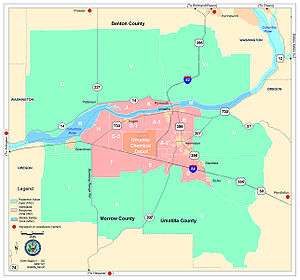Umatilla Chemical Depot
Coordinates: 45°50′35″N 119°26′17″W / 45.84306°N 119.43806°W

The Umatilla Chemical Depot, (UMCD) based in Umatilla, Oregon, was a U.S. Army installation in the United States that stored chemical weapons. The chemical weapons originally stored at the depot consisted of various munitions and 1 short ton (2,000 lb; 910 kg) containers containing GB and VX nerve agents and HD blister agent. All munitions had been safely destroyed by 2011 and base closure operations were expected to be completed by 2015.
History
The Umatilla Chemical Depot opened in 1941, to prepare for World War II. The depot's mission was to store and maintain a variety of military items, from blankets to ammunition. The depot took on its chemical weapons storage mission in 1962 and stored 12% of the nation's stockpile. From 1990 to 1994 the facility reorganized in preparation for eventual closure, shipping all conventional ammunition and supplies to other installations.
Chemical Weapons Destruction Facility
The Umatilla Chemical Agent Disposal Facility is designed for the destruction of the chemical weapons stored at the Umatilla Chemical Depot. The facility was completed in 2001. The Army began weapons disposal on September 8, 2004 and completed disposal on October 25, 2011.[1] Destruction is a requirement under the Chemical Weapons Convention and monitored by the OPCW. The facility destroyed 220,604 munitions and containers containing 3,717 short tons (7,434,000 lb; 3,372,000 kg) of GB, HD and VX via high-temperature incineration, representing 100 percent of the base's stockpile.[2] While destroying 50% of its stockpile took six years (until August 2010), the processing of the second 50% was expected to take only two years. The process is simplified by having only 1 short ton (2,000 lb; 910 kg) containers of HD remaining to be processed while multiple kinds of individual munitions containing several agents were destroyed early in the campaign. An emphasis on risk reduction prioritised destruction of the most modern and dangerous compounds (VX and GB) and destruction of smaller containers, which had greater risk of theft, explosion, and leakage.
Public participation and outreach
The Oregon Citizens' Advisory Commission, whose members include area residents appointed by the Governor, is a focal point for public participation in the Army's weapons storage and disposal program in Umatilla.
See also
- Chemical Weapons Convention
- Lethal Unitary Chemical Agents and Munitions
- Ordnance, Oregon
- Tooele Army Depot
References
External links
- Official site Umatilla Chemical Depot - the U.S. Army Chemical Materials Agency
- Aerial photo on flickr Aerial photograph of Umatilla Chemical Depot